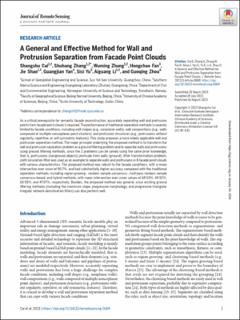| dc.description.abstract | As a critical prerequisite for semantic facade reconstruction, accurately separating wall and protrusion points from facade point clouds is required. The performance of traditional separation methods is severely limited by facade conditions, including wall shapes (e.g., nonplanar walls), wall compositions (e.g., walls composed of multiple noncoplanar point clusters), and protrusion structures (e.g., protrusions without regularity, repetitive, or self-symmetric features). This study proposes a more widely applicable wall and protrusion separation method. The major principle underlying the proposed method is to transform the wall and protrusion separation problem as a ground filtering problem and to separate walls and protrusions using ground filtering methods, since the 2 problems can be solved using the same prior knowledge, that is, protrusions (nonground objects) protrude from walls (ground). After transformation problem, cloth simulation filter was used as an example to separate walls and protrusions in 8 facade point clouds with various characteristics. The proposed method was robust to the facade conditions, with a mean intersection over union of 90.7%, and had substantially higher accuracy compared with the traditional separation methods, including region growing-, random sample consensus-, multipass random sample consensus-based, and hybrid methods, with mean intersection over union values of 69.53%, 49.52%, 63.93%, and 47.07%, respectively. Besides, the proposed method was general, since existing ground filtering methods (including the maximum slope, progressive morphology, and progressive triangular irregular network densification filters) can also perform well. | en_US |

